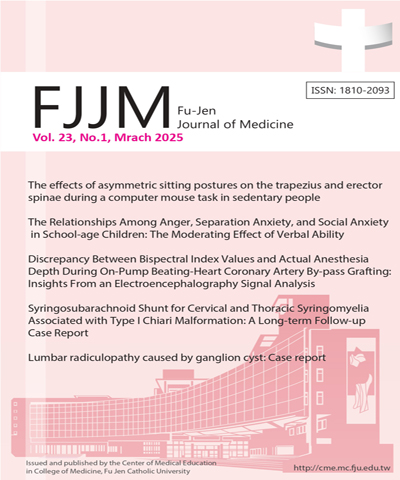
輔仁醫學期刊/Fu-Jen Journal of Medicine
輔仁大學醫學院,正常發行
選擇卷期
- 期刊
Background and Purpose: Lung cancer is the leading cause of cancer-related deaths in the world and Taiwan. Many lung cancer patients have comorbidities that significantly affect their overall survival. This retrospective study was conducted to investigate the comorbidity risk factors of systemic diseases for lung cancer patients by using Taiwan's nationwide, population-based database. Methods: All public insurance systems were placed under the universal National Health Insurance (NHI) program to ensure all Taiwan residents receive adequate health care. We searched the Longitudinal Health Insurance Database 2000 (LHID 2000) for the source population to identify the patients with lung cancer or not. The risk of lung cancer was estimated by calculating odds ratios (ORs) for patients with various comorbidities compared with patients without comorbidities. Results: A total of 3,799 cases of lung cancer were defined as study group, and a total of 15,196 subjects were identified as the control group. The lung cancer cohort had a high prevalence of pulmonary diseases and other systemic diseases, including gastric and duodenal ulcers, hepatobiliary and pancreatic disease, bacterial infections, and bacteremia (P < 0.05). In addition, the OR analysis showed that the sex-specific risk of lung cancer in the pleurisy stratification was higher in women than in men (OR =9.33 vs. 4.69; P< 0.001). Conclusion: Our results showed that significant comorbidity risk factors for lung cancer are not only related to pulmonary diseases but also in other organs or systems. Additional studies, especially population- based studies, are suggested to confirm these observations.
- 期刊
Background and purpose: Immunocompromised and elderly patients are at increasing risk of infection by Candida, a strain of fungus that can cause bloodstream infections in the critically ill. Methods: ICU patient data collected during 2009 to 2012 by four Southern Taiwanese hospitals was used to conduct a retrospective, multicenter study on candidemia patients older than 65 years of age. Results: Patient data for 198 patients was used for analysis. The mean age of all patients was 77.9. Mean Charlson comorbidity index (CCI) and APACHE II scores were 10.2 (± 3.3) and 28.1 (± 7.9), respectively. We found significantly higher rates of C. albicans candidemia in young-old patients compared to old-old patients (71.8% vs. 53.1%, P=0.008). Overall ICU and in-hospital mortality was 40.9% and 64.6%, respectively. Multivariate analysis found ICU mortality of candidemia patients to be significantly associated with prior exposure to broad spectrum antibiotics (P=0.039). Patients with high CCI scores and those who had recently undergone abdominal surgery were found to be less likely to contract non-albicans candidemia. Conclusion: We found significant differences between the clinical features and species distribution of candidemia in critically ill young-old and old-old patients. Prior exposure to broad spectrum antibiotics is a risk factor for candidemia, and also significantly impacts on mortality.
- 期刊
Reduction malarplasty is considered as one of the most common strategies for facial contouring for Asian patients. A 23-year-old female patient presented with sudden onset of consciousness disturbance after reduction malarplasty through the intraoral approach. Brain computed tomography (CT) revealed a left temporal epidural hematoma (EDH) with severe midline shift. Emergent craniectomy with hematoma evacuation was performed smoothly. The patient demonstrated substantial clinical improvement after the operation. Epidural hematoma resulting from injury to the middle meningeal artery is a rare but life-threatening complication of reduction malarplasty, and surgeons should be cautious about the possibility of this complication. Moreover, to the best of our knowledge, temporal EDH caused by injury to the MMA as a complication in reduction malarplasty has not previously been reported.
- 期刊
Simultaneous bilateral femoral neck fractures comprise an uncommon condition that is associated with metabolic bone disease, high-energy trauma, and seizure disorders. Its occurrence following low-energy trauma in the geriatric population due to osteoporosis is even rarer, with only a very few case reports to date. We herein report an 84-year-old female who sustained bilateral displaced femoral neck fracture that was successfully treated with single-stage bilateral cemented bipolar hemiarthroplasty. The mechanism of injury, clinical features, diagnosis, treatment options, and post-operative osteoporosis survey in achieving the best outcome are discussed along with a review of the available literature.

